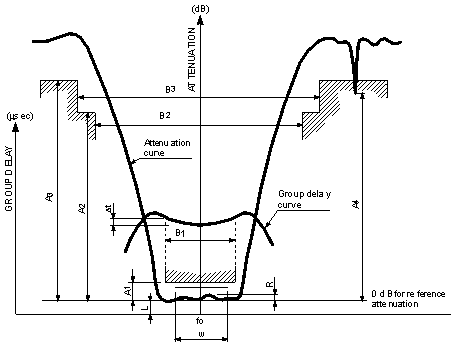Definitions
Basic definition
The filter is the passive four-terminal network, transmitting (or retenting) the defined frequency band.
Course of attenuating characteristic of the filter

Other terms and definitions
| Title | Symbol | Definition |
|---|---|---|
| Nominal frequency | fo [MHz] | Indicates the nominal center frequency of the band-pass or the nominal stop frequency of a band-stop filter |
| Poles | [–] | The number of poles of the transfer function |
| Nominal bandwidth (Pass band) |
B1 [kHz] | Minimal bandwidth of the pass-band at the attenuation A1 [dB] |
| Stop-bandwidth | B2, B3 [kHz] | Separation of frequencies between the relative attenuation of filter shall be equal to, or greater than, a specified value |
| Insertion loss | L [dB] | The logarithmic ratio of the power delivered to the load impedance before insertion of the filter to the power delivered to the load impedance after insertion of the filter |
| Pass-band ripple | R [dB] | Difference between the maximum value and the minimum value of attenuation within the pass-band B1 [kHz] of the filter |
| Alternate attenuation | A3 [dB] | Attenuation in a frequency range far outside of the pass band |
| Spurious response | A4 [dB] | Minimum attenuation caused by extraordinary response in the stop-band. Spurious response usually appears at higher frequency than the center frequency |
| Group delay distortion | Δt [ µs ] | The difference between the maximum and minimum group delay within the pass-band (B) unless otherwise specified |
| Terminating impedance | Zt Rt // Ct [ Ω // pF ] |
Either of the impedances presented to the filter by the source or by the load |
Reference
For more information about the crystal filters can be obtained from the following technical standards:
EN (IEC) 60 368-1, Piezoelectric filters of assessed quality – Part 1: Generic specification